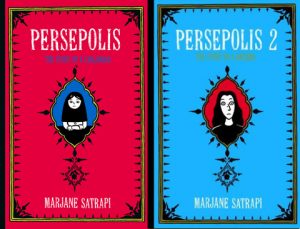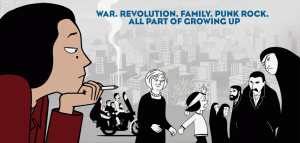Nonfiction at Its Best: Unraveling Marjane Satrapi’s Persepolis
Jonathan Smith // Blog Writer
 I heard of Marjane Satrapi’s memoir, Persepolis, back in high school, but never picked it up until my college history course last semester. I was ready to feel depressed because both parts of the memoir, Persepolis: The Story of a Childhood and Persepolis 2: The Story of a Return, centralize on the Iranian Revolution of 1979. Depression did settle in throughout the course of both the graphic novel and film versions, but Satrapi’s narrative also offers vitality through a celebration of what makes life fulfilling. As a reader or viewer, relating to Satrapi’s predicament is unexpectedly easy, which makes her account as accessible as it is significant.
I heard of Marjane Satrapi’s memoir, Persepolis, back in high school, but never picked it up until my college history course last semester. I was ready to feel depressed because both parts of the memoir, Persepolis: The Story of a Childhood and Persepolis 2: The Story of a Return, centralize on the Iranian Revolution of 1979. Depression did settle in throughout the course of both the graphic novel and film versions, but Satrapi’s narrative also offers vitality through a celebration of what makes life fulfilling. As a reader or viewer, relating to Satrapi’s predicament is unexpectedly easy, which makes her account as accessible as it is significant.
Given that I didn’t have a sturdy foundation of knowledge on the Iranian Revolution—or even Iran and the Middle East for that matter—I was unsure as to how much information I would be able to grasp. But Satrapi gives the necessary details in both versions, helping the audience understand the politics of the time and their subsequent effect on her family. I never felt as though the concepts were too hard to understand. Perhaps the most compelling aspect of both versions is that Satrapi never shies away from controversial topics—religion, self-discovery, sexism, and the politics of authority are all prominent concepts.
The graphic novel and film do not differ from each other too greatly; after all, this is Satrapi’s nonfictional account, so changing the storyline wouldn’t make sense. Both versions depict Satrapi’s life from childhood to adulthood in black-and-white comic book style, with the exception of color in select scenes such as the beginning of part two. The art style lends to the accessibility of Satrapi’s story. For example, one scene shows Satrapi returning home only to find that the house across the street from hers has been bombed, and it is heavily implied that her friend died. It’s somewhat easier to mentally work through difficult moments such as these because they may only last two pages in the graphic novel instead of a full chapter in a book.
 What’s most impressive about Satrapi’s storytelling is the connection she creates with her audience from the very beginning. She’s only ten or so at the time when the Iranian Revolution begins, and she has questions just as any innocent child naturally would. She’s trying to comprehend the conflict; the audience is as well. The audience can also relate when Satrapi grows older, hangs out with friends, talks about boys, sings Kim Wilde’s “Kids in America,” and ventures out to Europe in what acts dually as a safety precaution and a search for self-discovery. Her relationships with her mother, father, and grandmother are organic and effectively portray the flaws and nuances applicable in each. Satrapi doesn’t just invite her audience into her life; she implores us to envision ourselves in her shoes.
What’s most impressive about Satrapi’s storytelling is the connection she creates with her audience from the very beginning. She’s only ten or so at the time when the Iranian Revolution begins, and she has questions just as any innocent child naturally would. She’s trying to comprehend the conflict; the audience is as well. The audience can also relate when Satrapi grows older, hangs out with friends, talks about boys, sings Kim Wilde’s “Kids in America,” and ventures out to Europe in what acts dually as a safety precaution and a search for self-discovery. Her relationships with her mother, father, and grandmother are organic and effectively portray the flaws and nuances applicable in each. Satrapi doesn’t just invite her audience into her life; she implores us to envision ourselves in her shoes.
Without a doubt, there are many misconceptions of the Middle East and its residents, perhaps today more so than ever. Satrapi’s narrative encapsulates what it was like for the everyday person to live through such a difficult time as the Iranian Revolution while also reflecting on what her Iranian heritage means to her nowadays. A major theme of Persepolis is Satrapi’s struggle to find her identity, how she feels about and how others perceive her for being Iranian. It takes bravery to articulate such personal, authentic life experiences for the world to read and see. I recommend acquiring copies of both mediums. The couple of hours it takes to read the memoir or watch the film are nothing compared to the story that remains embedded in your memory long after.
